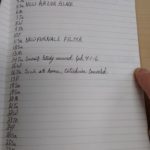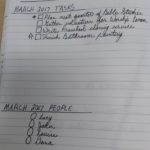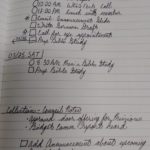 Pastor Stephen Daly serves St. Paul Lutheran Church and School in South Haven, MI. He’s used a Bullet Journal (bulletjournal.com) for task management since 2013. On episode 491, WELSTech talked with Pastor Daley about how he uses the Bullet Journal system. He shared this information about his experience:
Pastor Stephen Daly serves St. Paul Lutheran Church and School in South Haven, MI. He’s used a Bullet Journal (bulletjournal.com) for task management since 2013. On episode 491, WELSTech talked with Pastor Daley about how he uses the Bullet Journal system. He shared this information about his experience:
Even if you love your digital devices and apps, sometimes you need a break from the digital world. Have you noticed that you spend more time organizing your tasks in your digital task application than doing them? Have you noticed that you often skip your weekly reviews of your tasks? If you can relate to anything that was mentioned, perhaps the Bullet Journal will become one of the most useful ministry tools in your toolbox.
By design, the Bullet Journal (bulletjournal.com), commonly abbreviated BuJo, is an analog tool for task and project management. All you need is a notebook with some blank pages and a pen or pencil. On your daily pages, you use bullets to mark things as tasks, appointments, or information. You can use additional symbols called signifiers to mark tasks as important or moved. Really it is as simple as having a system for dealing with all of the lists that we often create in our lives to keep us organized.
Into a blank notebook create put page numbers at the bottom of the pages and get started with the following pages in your notebook:
- INDEX: A listing of the different “spreads” (pages devoted the same month, project, meeting notes, Bible Study notes, etc.) with the page numbers listed.
- This enables you to find collections and information easily.
- 2-4 pages are all you should need to reserve for your index.
- FUTURE INDEX: A page divided by the future 6-12 months
- This is a great place to record upcoming events that you don’t want to forget about like a family vacation or the date of a Mission Festival or a medical procedure that you need to schedule in the future.
- 1-2 pages are all you should need.
- MONTH CALENDAR: A single line journal of significant things you want to remember during the month.
- This is where you can note when you changed your furnace filter, had your last dental cleaning, had a special church or school event, or had a visit with a prospect.
- I would not use this as your appointment calendar, because you will probably run out of space, on certain days. I use Google Calendar for my appointment calendar. Others who prefer paper will use a full 12-month paper calendar.
- 1-2 pages are enough.
- MONTHLY TASK LIST: These are unique projects or tasks you intend to get done that month.
- MONTHLY PEOPLE LIST: This is a unique feature I have added to my Bullet Journal.
- I use this to list all of the people I want to see face to face like: Shut-ins, Prospects, Delinquents.
- 1 page is enough.
- DAILY PAGES: This is the best part of the system.
- Use your daily pages to write down all of the appointments and tasks that you have for that day.
- Keep your Bullet Journal open during the day and add to your daily pages everything that pops up. I write additional tasks that I think of (even if I might not do it that day). I write down my mileage on these pages, notes about members and family that I want to remember, ideas for future projects, and notes from my daily devotions.
- Often I can fit 2-5 days on two facing pages sometimes less, sometimes more. Whenever I have to turn the page, I use this as an opportunity to review.
- COLLECTIONS: These are simply groups of pages where you have collected a lot of information that maybe wouldn’t fit easily on the daily pages. Examples:
- Notes taken from a commentary on an upcoming sermon text
- Notes taken during a meeting with a mix of tasks and information
- Drafts of documents, Bible studies, or lessons
- Project planning or brainstorming
- Funeral plans: When I meet with a family, I will open to a new page, and write down their cell phone #’s, hymn requests, and scripture requests so I have everything on one page.
MY REVIEW PROCESS of MONTHLY, DAILY, and COLLECTIONS:
- UNDONE TASKS: Is it urgent? I draw an arrow, and move that task to the current daily page. Is it a Someday/Maybe task? I move it to my digital Someday/Maybe tasks list. Is it important, but not urgent? I move it to my “Monthly Task List.” Is it no longer worth doing? I cross it out and move on.
- INFORMATION NOTES: Is it a date? I move it into Google Calendar. Is it mileage or expenses? I move it to my Digital Mileage Expense Report. Is it information I want to refer back to? I move it into my Digital Archive either in Google Drive or OneNote.
When I’m done with all of the information on a page I put a big red check mark at the top so I know that I don’t have to look at that page again.
Photos from Pastor Daley’s Bullet Journal
- Sample Index & Future Log
- Sample Calendar
- Sample Monthly Tasks and People
- Sample Daily Page
- Bullet Journals of all types
- Current Bullet Journal with mobile Bullet Journal






